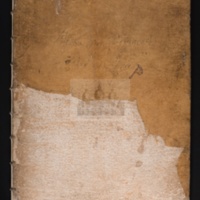Choirbook 1
| SHELF MARK | Basilica di San Marco, Libri musicali 1 |
| SHORT TITLE | Giovanni Croce: Missa pro defunctis |
DESCRIPTION
| IDENTIFIER | DOI: 10.14277/unive/vmo/soundstmark/2017/choirbook1 |
| PHYSICAL DESCRIPTION | 22 sheets: 1 front flyleaf 21 sheets In-plano. Maximum sheet size (mm): 742 (height) x 510 (width) The main body of the manuscript consists of five gatherings, each comprising two bifolios, obtained by gluing together two folios in-plano. The resulting twenty folios are numbered from 2 to 20 in the upper right corner, beginning on the recto of the second folio. An unnumbered folio was added at the back and, at a later stage (probably during renewal of the binding), a front flyleaf. A large lacuna towards the bottom of the front flyleaf was re-integrated during restoration in 2015. |
| BINDING | Binding in paperboard and parchment with endpapers. Nine single raised bands with cord stitching, of which three broken (and replaced during restoration in 2015, without total removal of the original binding). The parchment on the covers presents many lacunae: on the front, little more than the upper half survives; and, on the back, a strip near the spine. During restoration in 2015, the evident signs of wear and tear in the margins and lower corners of the manuscript (distortion, erasures, lacunae) were partly eliminated. |
| MATERIAL |
Paper: 2 types Type 1 (front flyleaf and f. 21) Paper chain line (mm): 33 Watermark 1 (centre of half-sheet): Trefoil with letters ‘P’ ‘B’(?) Type 2 (fols 1-20) Paper chain line (mm): 33 Watermark 2 (corner of sheet): Trefoil with letters ‘S’ ‘S’ |
| DATING | 1683 / 1691 |
| COPYIST(S) | Three copyists Copyist 1: de Sartis, Giovanni Francesco De Sartis is the main copyist of the manuscript (fols 1-21). He is named on fol. 20v: ‘Ioannes Franciscus de Sartis Musicus scrip[sit]’ (see also Choirbooks 2, 8, and 18). He is also the copyist of the folio containing the text (without music) of five responsories of the Ordo exequiarum (fol. 21). Copyist 2: Anonymous 1 A later, anonymous copyist inserted a 4-part setting of the De profundis (fols 19v-20r) after Croce’s mass. Copyist 3: Anonymous 2 A later, anonymous copyist inserted the text (without music) of the responsory Libera me Domine with associated verses (used at the Absolution of the Dead) on the back endpaper. |
| INVENTORY | Marchio Angeli (1720) no. 17 |
| NOTES | Sheet 21r-v contains the text (without music) of the following five responsories: Subvenite Sancti Dei Qui Lazarum resuscitasti Domine quando veneris Ne recorderis peccata Libera me Domine A paste-over on the back endpaper contains the text of the responsory Libera me Domine with associated verses (used at the Absolution of the Dead). The verso of the front flyleaf (bottom) contains a label with the number ‘8’; this presumably stems from an earlier numbering of the Choirbooks. |
| LITERATURE | Collarile: Suono dell’eterno Passadore, Rossi: San Marco, no. 1924 |
CONTENT
Choirbook 1_01
| TITLE IN SOURCE | [Recto of first sheet with music:] ‘MISSA / PRO / DEFVNCTIS / IO: A’ CRVCE’ |
| INCIPIT | Requiem aeternam dona eis Domine |
| COMPOSER | Croce, Giovanni |
| DESCRIPTION | Requiem aeternam dona eis Domine (fols 1v-4r) Kyrie eleison (fols 4v-7r) Dies irae, dies illa (fols 7v-17r) Sanctus, sanctus, sanctus Dominus Deus (fols 17v-19r) Agnus Dei (fols 18v-20r) |
| SCORING | 4 vocal parts: Cantus, Altus, Tenor, Bassus. The Dies irae is for two, 4-part choirs (Cantus, Altus, Tenor, Bassus), which re-unite in a final (4-part) Tutti. |
| CLEFS | C3, C4, C4, F4 |
| LITURGICAL SOURCE | Requiem Mass |
| LITURGICAL FEAST | All Souls’ Day, Funerals |
| LITURGICAL GENRE | Requiem Mass |
| LITURGICAL SOURCE | Requiem Mass |
| TEXT | Requiem aeternam dona eis, Domine, et lux perpetua luceat eis. Te decet hymnus Deus in Sion et tibi reddetur votum in Ierusalem, exaudi orationem meam, ad te omnis caro veniet. Requiem aeternam dona eis, Domine, et lux perpetua luceat eis. Kyrie eleison. Christe eleison. Kyrie eleison. Dies irae, dies illa solvet saeclum in favilla teste David cum Sybilla. Quantus tremor est futurus quando iudex est venturus cuncta stricte discussurus. Tuba mirum spargens sonum per sepulchra regionum coget omnes ante thronum. Mors stupebit et natura cum resurget creatura iudicanti responsura. Liber scriptus proferetur in quo totum continetur unde mundus iudicetur. Iudex ergo cum sedebit quidquid latet apparebit nil inultum remanebit. Quid sum miser tunc dicturus quem patronum rogaturus cum vix iustus sit securus. Rex tremendae maiestatis qui salvandos salvas gratis salva me fons pietatis. Recordare Iesu pie quod sum causa tuae viae ne me perdas illa die. Quaerens me sedisti lassus redemisti crucem passus tantus labor non sit cassus. Iuste iudex ultionis donum fac remissionis ante diem rationis. Ingemisco tamquam reus culpa rubet vultus meus supplicanti parce Deus. Qui Mariam absolvisti et latronem exaudisti mihi quoque spem dedisti. Preces meae non sunt dignae sed tu bonus fac benigne ne perenni cremer igne. Inter oves locum praesta et ab haedis me sequestra statuens in parte dextra. Confutatis maledictis flammis acribus addictis voca me cum benedictis. Oro supplex et acclinis cor contritum quasi cinis gere curam mei finis. Lacrimosa dies illa qua resurget ex favilla iudicandus homo reus. Huic ergo parce Deus. Pie Iesu Domine dona eis requiem. Amen. Sanctus, sanctus, sanctus Dominus Deus Sabaoth. Pleni sunt caeli et terra gloria tua. Hosanna in excelsis. Benedictus qui venit in nomine Domini. Hosanna in excelsis. Agnus Dei, qui tollis peccata mundi, dona eis requiem. Agnus Dei, qui tollis peccata mundi, dona eis requiem sempiternam. |
| TRANSCRIPTION |
|
| OTHER SOURCES | I-Vsm, B.801/1-24 (see Passadore, Rossi: San Marco, no. 571) I-CHc, 50 D 29 (=17828) These two manuscripts transmit a different version of the ‘Agnus Dei’ and contain two additional sections: the Offertorium ‘Domine Jesu Christe’ and the Postcommunio ‘Lux aeterna luceat eis Domine’. |
| NOTES | The manuscripts I-Vsm, B.801 and I-CHc, 50 D 29 (=17828), both dating from the first half of the 19th century, indicate 1598 as a possible date of composition. According to Arnold (Cavalli at St Mark’s, p. 274), Croce’s Missa pro defunctis was written for the funeral of Doge Marino Grimani (†1605). In reality, Croce composed a concertato mass for the occasion; this mass is no longer extant, though it was still preserved in the musical archive of St Mark’s at the beginning of the 19th century (cf. Caffi: San Marco, p. 156). Croce’s Missa pro defunctis continued to be performed for over three centuries at St Mark’s, both on All Souls’ Day (2 November) and, in all probability, during solemn funerals and masses commemorating the souls of the dead – for example, the annual commemoration of Cardinal Giovanni Battista Zen (†1501). It may also have been used in other Venetian churches where the singers of the ducal chapel served annually of on one-off occasions (Collarile: Suono dell’eterno). No documentary evidence relating specifically to the compilation of Choirbook 1 is known. However, the volume must date from the period between 1683 and 1691, when Giovanni Francesco de Sartis was active as copyist at St Mark’s. De Sartis must have used an earlier source (presumably a choirbook), subsequently eliminated. Choirbook 1 transmits some interesting details of performance practice. The Dies irae is written for two choirs, which alternate strophe by strophe. The normal choirbook layout of the manuscript is here modified: the four parts of Choir 1 are notated on the verso of each folio, the four parts of Choir 2 on the recto. This layout perhaps reflects the location of the two groups on the ‘pulpitum magnum’ ('bigonzo'). The limited dimensions of the bigonzo certainly precluded all stereophonic effects. The structure of the Dies irae is reminiscent of a practice attested at St Mark’s for much of the 16th and throughout the 17th centuries: the responsorial performance of double-choir psalms from the bigonzo, with four singers in one choir and the remainder in the other (Bryant: The cori spezzati, in particular pp. 169-172). |
| LITERATURE | Arnold: Cavalli at St Mark’s Bryant: The cori spezzati Caffi: San Marco Collarile: Suono dell’eterno Moore: Vespers at St Mark'sPassadore, Rossi: San Marco, no. 1924 |
IMAGES 
